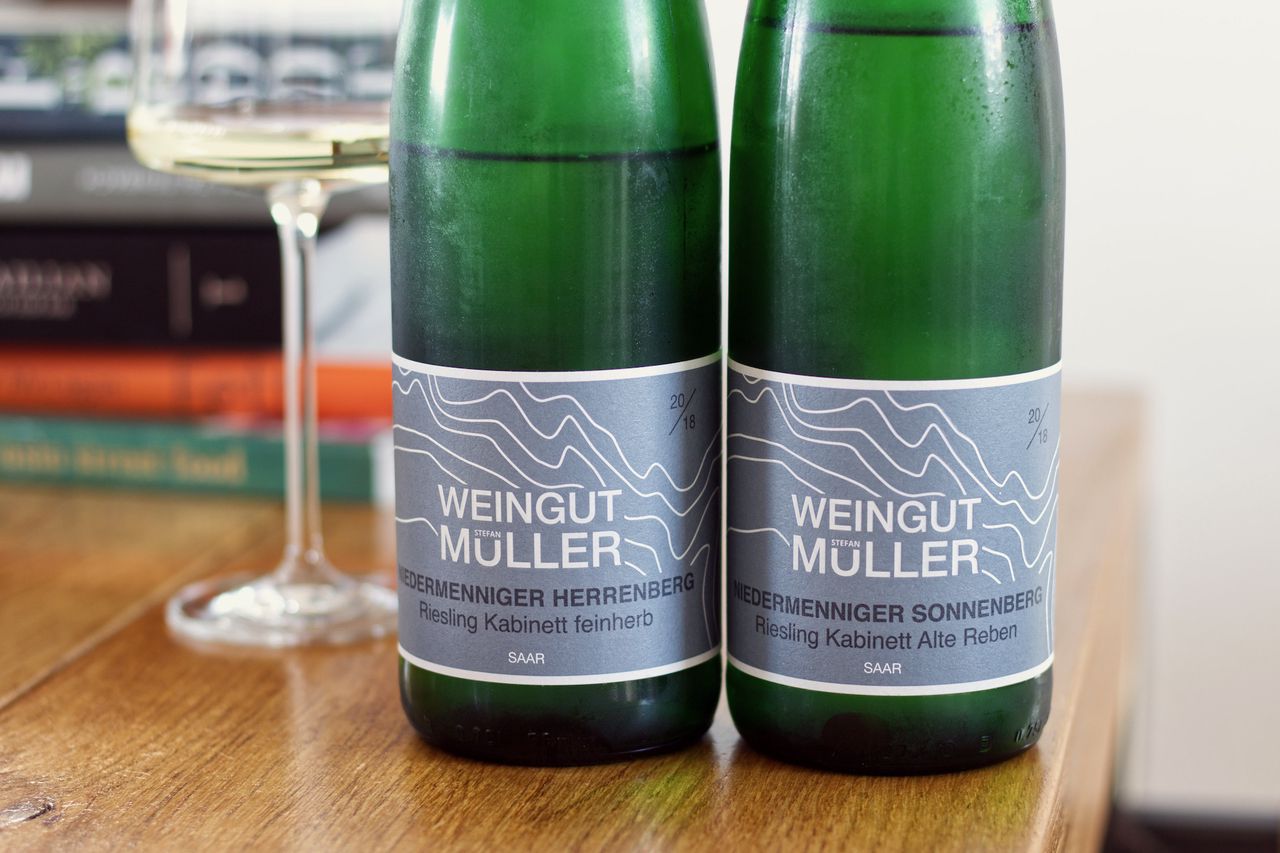Two Bottles Stefan Müller
We drink two bottles of Riesling Kabinett 2018 from Stefan Müller's Niedermennig vineyards Herrenberg and Sonnenberg.

The international audience certainly has a lot of fun with the pronunciation of the two site names Niedermenniger Herrenberg and Niedermenniger Sonnenberg. I mean they hardly fit on the picture of the bottles and that has to mean something already. I admit that also with me these long vineyard names do not burn themselves exactly into the memory. At the same time, however, I find that this is exactly what makes German wine and if you are honest, some site and origin designations from the surrounding countries are not really much shorter or more memorable either. Then, as a bonus, there’s the predicate: Kabinett. One is feinherb and the other with a little more residual sugar but from old vines. Kabinett is itself only the lowest predicate level and thus depends on the sugar content of the grapes at harvest and a few other legal requirements. Added sugar is not allowed. Otherwise, a lot is possible from dry to sweet. Many wine drinkers, myself included, certainly associate Kabinett with Riesling from Mosel, Saar and Ruwer, the play of acidity and residual sugar and moderate alcohol. And today’s two bottles also come from there. Stefan Müller makes wine in the eponymous winery in the third generation and, in his early 30s, still has many years ahead of him. The winery cultivates just over 10 hectares of vines, which are planted primarily with Riesling on steep slate slopes. This generally forces a lot of manual labor. The wines are then fermented with wild yeasts after harvest and aged in steel or traditional wooden barrels.
We start with the Niedermenniger Herrenberg Kabinett feinherb. There is relatively little fruit coming out of the glass, but a whole lot of stone. The wine feels cool and enormously focused. In the mouth, it has a light citrus note and a crisp acidity. The wine comes in at 10% alcohol and about 25 grams of residual sugar, but not much of that is noticeable due to the acidity. Not that the wine is sour, but it does have a punch and pulls on the cheeks.
A day of air really helps the wine develop. The nose becomes more intense and deeper. The dominant note remains the wet stone, but the fruit can now counter this more. And on the tongue, too, the Riesling seems a bit sweeter and fruitier. Which is not to say that it has lost acidity, and the elegance has not been lost either. This is so perfectly suited to the Saar with its reputation of purist Rieslings with a lively acidity.
The Niedermenniger Sonnenberg Kabinett Alte Reben weighs in at 9%, a bit less alcohol, but about 20 grams more sugar per liter. The Kabi starts even more reserved than the Herrenberg. Clearly reductive, flint, minerality. On the tongue is pome fruit and other light yellow fruits. You can taste the extra sugar, but even in this wine the acidity has something to counteract it. It does seem creamier than the other bottle, though. Relatively quickly, floral aromas come to the nose and herbs to the tongue.
In contrast to the off-dry counterpart, there is less development overnight. The wine is just as straight as it left off the first evening. Little fruit, lots of flint on the nose. Where the nose seems a bit more austere, it is fuller in the mouth and also a bit rounder. For me, this is the more balanced wine today and therefore just has the edge in a direct comparison. It has everything I expect from Kabi, is precise, has power, fruit, stone and really packs a punch. Everything is there and for the 9 euros that it cost at the time, it was a real bargain. The current vintage costs around 11 euros. But only if you are quick, the wines are actually sold out pretty fast.
Related Posts
- Forstmeister Geltz Zilliken - Rausch Kabinett 2017
- von Hövel - Monopollage Hörecker 2015
- Carl Loewen - Maximin Herrenberg 2018